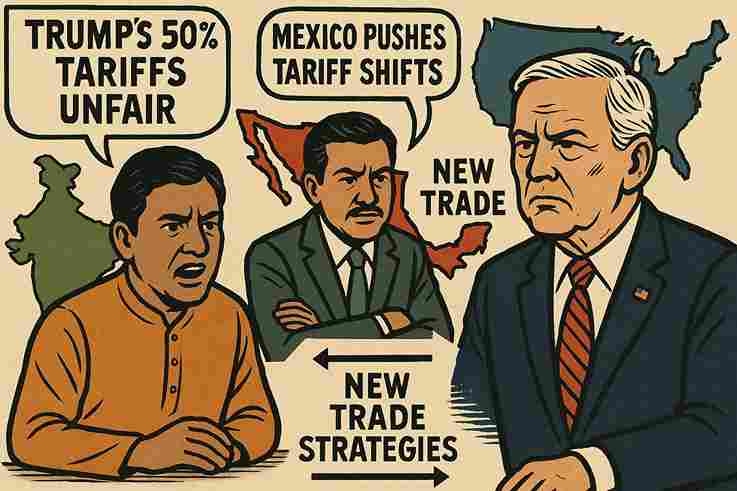A New Wave of Tariffs From Washington
Trade tensions are heating up again. In August 2025, the United States, under Donald Trump’s administration, announced sweeping tariffs on key trading partners. India was hit the hardest with a 50% tariff on exports, while Mexico faced 30% duties on a wide range of goods. The move has rattled global markets, tested old alliances, and pushed both countries to rethink their economic strategies.
India’s Response: Balancing Resistance and Resilience
For India, the tariffs landed like a thunderclap. Washington justified the hike by pointing to India’s continued purchase of discounted Russian oil, along with long-standing trade frictions. Prime Minister Narendra Modi called the action “unfair and unreasonable,” warning that the U.S. was weaponizing trade to dictate foreign policy.
Instead of jumping into an all-out trade war, India’s leadership has chosen a more measured path. The government is rolling out domestic relief measures—cutting GST in select sectors, supporting exporters most affected by the tariffs, and boosting local demand to soften the blow. At the same time, India is actively diversifying trade partners, deepening ties with Southeast Asia, the Middle East, and even exploring cautious cooperation with China.
Political voices at home, though, are split. Opposition leaders such as Arvind Kejriwal demanded a 100% retaliatory tariff on U.S. imports, accusing Modi of being too soft. On the other hand, the Rashtriya Swayamsevak Sangh (RSS), the ruling party’s ideological ally, took a neutral stance, saying it would back whatever steps the government considered necessary. This mix of restraint and pressure shows just how politically charged the issue has become inside India.
Mexico’s Position: Careful Strategy Over Confrontation
Mexico, meanwhile, has been navigating the storm differently. Trump’s 30% tariff on Mexican exports—part of a broader tariff package that also targeted the EU—was labeled “unfair” by Mexican officials. The concern is not just about lost revenue but the ripple effects on supply chains, since Mexico plays a central role in North American manufacturing.
But instead of escalating tensions with Washington, Mexico is fine-tuning its own trade policy. In its 2026 budget draft, the government proposed higher tariffs on imports from China—particularly in sectors like cars, textiles, and plastics. This move not only shields Mexican manufacturers but also aligns the country more closely with Trump’s “Fortress North America” agenda.
Mexico’s approach reflects pragmatism. By adjusting tariffs against non-U.S. rivals rather than retaliating directly against Washington, Mexico keeps the door open for cooperation while still defending its economic interests.
Trade War History Shapes Choices
This isn’t Mexico’s first rodeo with Trump-era tariffs. Earlier in 2025, when Washington imposed duties on both Mexico and Canada, many expected a sharp backlash. Instead, Mexico leaned on exemptions within the USMCA (the updated NAFTA agreement) and used diplomatic channels to shield much of its trade. That experience seems to have shaped today’s strategy: avoid open confrontation, stay flexible, and adapt quietly.
India, in contrast, has a more complex relationship with the U.S. While trade is important, New Delhi also guards its independence in foreign policy—especially in energy deals with Russia. That tension makes it harder for India to compromise without looking like it’s bending under pressure.
Why This Matters Globally
The ripple effects of these tariffs won’t stop at the borders of India or Mexico. For businesses worldwide, supply chains are once again in flux. Companies relying on Indian exports may face higher costs, while U.S. consumers could feel the pinch if retaliatory measures push prices up. Mexico’s adjustment against Chinese imports could also shift trade flows across Latin America and Asia.
At a broader level, these moves signal a new phase of economic nationalism, where countries are being forced to pick sides or redesign strategies to weather unpredictable U.S. trade policies. India’s cautious balancing and Mexico’s calculated alignment show two very different ways of handling the same storm.
The Road Ahead
Both India and Mexico are proving that tariffs don’t always have to trigger rash retaliation. India is playing the long game by building resilience at home and broadening its global partnerships. Mexico is playing the smart game, protecting its industries while avoiding a showdown with its most powerful neighbor.
For now, the big question is whether Trump’s tariff gamble will bring leverage to Washington—or spark a wave of counter-moves that weaken U.S. trade influence. One thing is clear: India and Mexico are not folding. They are adapting, recalibrating, and shaping a new economic playbook for an uncertain world.
Also read:




